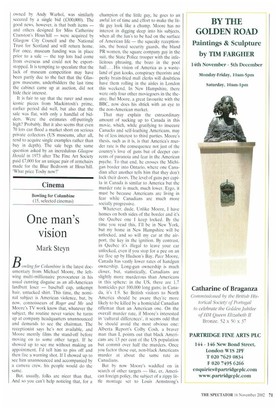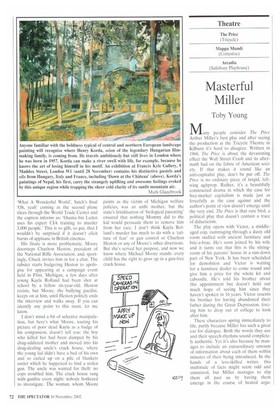Bowling for Columbine (15, selected cinemas)
One man's vision
Mark Steyn
B°Kling for Columbine is the latest documentary from Michael Moore, the leftwing multi-millionaire provocateur in his usual cunning disguise as an all-American lardbutt loser — baseball cap, unkempt hair, untucked shirt. This time, the nominal subject is American violence, but, by now, connoisseurs of Roger and Me and Moore's TV work know that, whatever the subject, the routine never varies: he turns up at company headquarters unannounced and demands to see the chairman. The receptionist says he's not available, and Moore merrily films the stand-off before moving on to some other target. If he showed up to see me without making an appointment. I'd tell him to piss off and then fire a warning shot. If I showed up to see him unannounced and accompanied by a camera crew, his people would do the same.
But. usually, folks are nicer than that. And so you can't help noticing that, for a champion of the little guy, he goes to an awful lot of time and effort to make the little guy look like a chump. Moore has no interest in digging deep into his subjects, when all the fun's to be had on the surface of American life — the squeaky receptionists, the bored security guards, the bland PR women, the square company guy in the suit, the State Police trooper with the infelicitous phrasing, the bozo in the pool hall ... His vision of America as a wasteland of gun kooks, conspiracy theorists and perky brain-fried mall clerks will doubtless have them rolling in the aisles in London this weekend. In New Hampshire, there were only four other moviegoers in the theatre. But Moore, a great favourite with the BBC, now does his shtick with an eye to the non-American market.
That may explain the extraordinary amount of sucking up to Canada in this movie, which, while gratifying to insecure Canucks and self-loathing Americans, may be of less interest to third parties. Moore's thesis, such as it is, is that America's murder rate is the consequence not just of the country's love of guns but of deeper currents of paranoia and fear in the American psyche. To that end, he crosses the Michigan border into Ontario, where one Canadian after another tells him that they don't lock their doors. The level of guns per capita in Canada is similar to America but the murder rate is much, much lower. Ergo, it must be because Americans are living in fear while Canadians are much more socially progressive.
Whatever, dude. Unlike Moore, I have homes on both sides of the border and it's the Quebec one I keep locked. By the time you read this. I'll be in New York, but my home in New Hampshire will be unlocked, and so will my car at the airport, the key in the ignition. By contrast. in Quebec it's illegal to leave your car unlocked, even if you stop for a pee on an ice floe up by Hudson's Bay. Pace Moore, Canada has vastly lower rates of handgun ownership. Long-gun ownership is much closer, but, statistically, Canadians are slightly more murderous than Americans in this sphere: in the US, there are 1.7 homicides per 100,000 long guns; in Canada, it's 1.9. So British visitors to North America should be aware they're more likely to be killed by a homicidal Canadian rifleman than an American one. On the overall murder rate, if Moore's interested in 'cultural differences', it seems odd that he should avoid the most obvious one: Alberta Report's Colby Cosh, a braver man than I, points out that black Americans are 13 per cent of the US population but commit over half the murders. Once you factor those out, non-black Americans murder at about the same rate as Canadians.
But by now Moore's waddled on in search of other targets — like, er, American foreign policy, the subject of a zippy little montage set to Louis Armstrong's 'What A Wonderful World', Satch's final 'Oh, yeah' coming as the second plane slices through the World Trade Center and the caption informs us: `Osama bin Laden uses his expert CIA training to murder 3,000 people.' This is so glib, so pat, that I wouldn't be surprised if it doesn't elicit bursts of applause in British cinemas.
His finale is more problematic. Moore doorsteps Charlton Heston, president of the National Rifle Association, and, sportingly, Chuck invites him in for a chat. The tubster starts badgering Heston to apologise for appearing at a campaign event held in Flint, Michigan, a few days after young Kayla Rolland had been shot at school by a fellow six-year-old. Heston resists, but Moore, the bullying pacifist, keeps on at him, until Heston politely ends the interview and walks away. If you can identify any point to this stunt, let me know.
I don't mind a bit of selective manipulation, but here's what Moore, touting his picture of poor dead Kayla as a badge of his compassion, doesn't tell you: the boy who killed her had been dumped by his drug-addicted mother and moved into his drug-dealing uncle's crack house, where the young lad didn't have a bed of his own and so curled up on a pile of blankets under which he happened to find a stolen gun. The uncle was wanted for theft: no cops troubled him. The crack house rang with gunfire every night: nobody bothered to investigate. The woman, whom Moore
paints as the victim of Michigan welfare policies, was an unfit mother, but the state's fetishisation of 'biological parenting' ensured that nothing Mommy did to the kid would persuade them to remove him from her care. I don't think Kayla Rolland's murder has much to do with a 'culture of fear' or gun control or Charlton Heston or any of Moore's other diversions. But she's served her purpose, and now we know where Michael Moore stands: every child has the right to grow up in a gun-free crack house.



























































































 Previous page
Previous page